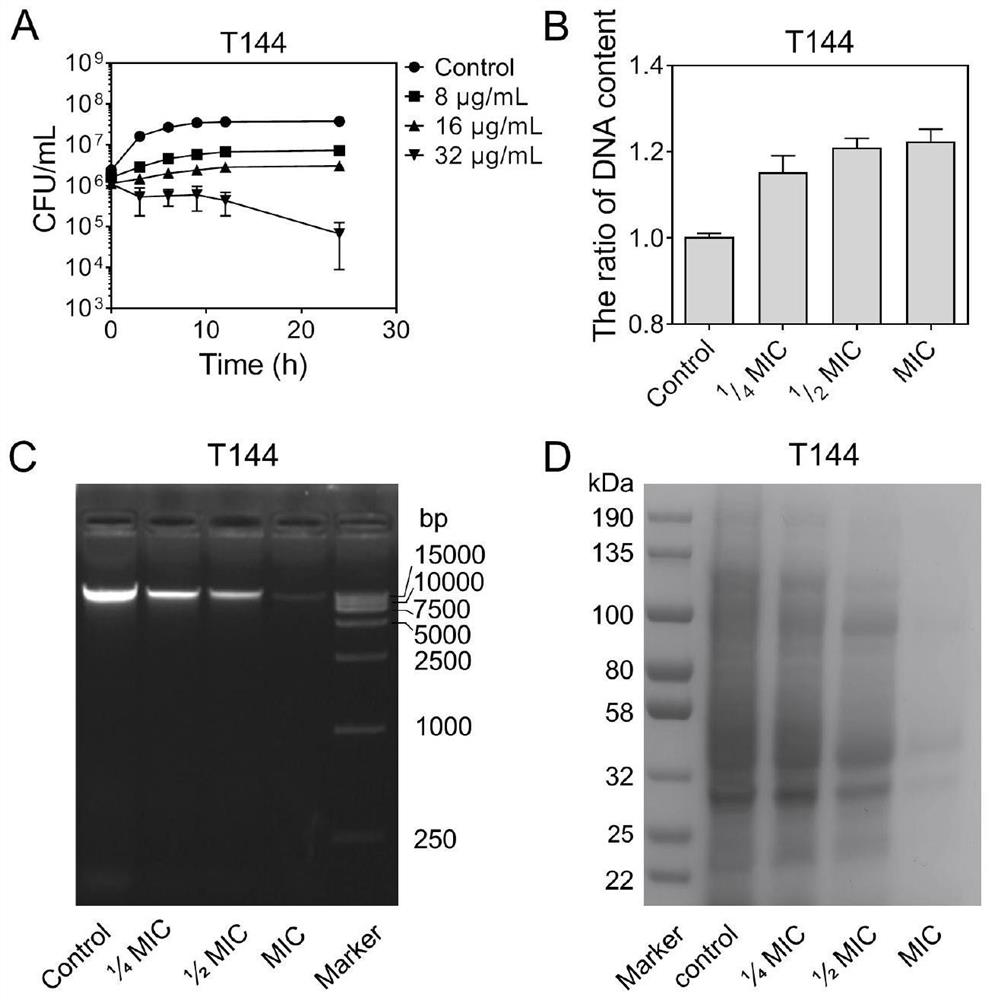New antibacterial application of cyanine dye ir780
A technology of dyes and cyanines, which can be used in antibacterial drugs, medical preparations containing active ingredients, and resistance to media-borne diseases. It can solve the problems of direct antibacterial effects that have not been reported, and achieve the effect of alleviating bacterial infections.
- Summary
- Abstract
- Description
- Claims
- Application Information
AI Technical Summary
Problems solved by technology
Method used
Image
Examples
Embodiment 1
[0078] Embodiment 1: IR780 is measured to the MIC value of bacteria
[0079] According to the microbroth dilution method recommended by the American Clinical Laboratory Standards Institute (CLSI), the MIC of standard strains and clinical isolates of IR780 was determined, and the MIC results were judged mainly according to the CLSI M100-S25 (2015) standard. Use MH medium to dilute the drug to 512, 256, 128, 64, 32, 16, 8, 4, 2, 1 μg / mL, respectively add to the first 10 wells of a 96-well U-shaped plate, and use MH medium to detect strains diluted to 10 5 -10 6 CFU / mL, add 100 μL per well into the drug-containing wells, add 100 μL medium in the 11th hole as a negative control, and add 100 μL bacterial solution in the 12th well as a positive control. Place in a 37°C incubator for 12-16 hours, read the results, and the minimum concentration that inhibits bacterial growth is the MIC value. In order to ensure the accuracy of the experimental results, the experiment was repeated ...
Embodiment 2
[0083] Embodiment 2: IR780 is measured to the time sterilization curve of bacteria
[0084] The strains in Table 1 were grown to the logarithmic phase of the bacteria solution (OD 600 =0.8~1) Dilute 1:1000 times, take 1mL of the diluted bacterial solution and add it to the shaker tube. According to the experimental results of MIC, different concentrations of IR780 (0-32 μg / mL) were incubated with the bacterial liquid at 37°C and 250 rpm, and the control group did not add the liquid. 30 μL was taken at 0, 3, 6, 9, 12, and 24 h to coat the plate. After the plate was placed at 37°C for 12-16 hours, count single colonies and draw a growth curve to observe the growth trend of bacteria.
[0085] The result is as Figure 1-11 As shown in Figure A, the bacteria in each control group grew and multiplied rapidly within 0-12 hours, and the bacteria grew in a stable period within 12-24 hours. After adding different concentrations of IR780, the growth of each bacterium was significantl...
Embodiment 3
[0086] Example 3: Effect of IR780 on Bacterial DNA Extravasation
[0087] The strains in Table 1 were grown to the logarithmic phase of the bacteria solution (OD 600 =0.8~1) Dilute 1:1000 times with MH broth, take 1mL of the diluted bacterial solution and add it to the shaker tube. According to the experimental results of MIC, drug concentrations of 1 / 4MIC, 1 / 2MIC and MIC were selected to incubate with bacterial solution at 37°C and 250rpm, and the control group did not add drug solution. After incubation for 12 hours, centrifuge at 12000 rpm for 2 minutes, collect the supernatant, and measure the DNA content in the supernatant with a micro-spectrophotometer.
[0088] The result is as Figure 1-11 As shown in Figure B, in order to detect the effect of IR780 on the permeability of the bacterial cell membrane, the extravasation of intracellular macromolecular substances (DNA) was further measured after adding the drug. After incubation for 12 hours, 1 / 4MIC, 1 / 2MIC and MIC of ...
PUM
 Login to View More
Login to View More Abstract
Description
Claims
Application Information
 Login to View More
Login to View More - R&D
- Intellectual Property
- Life Sciences
- Materials
- Tech Scout
- Unparalleled Data Quality
- Higher Quality Content
- 60% Fewer Hallucinations
Browse by: Latest US Patents, China's latest patents, Technical Efficacy Thesaurus, Application Domain, Technology Topic, Popular Technical Reports.
© 2025 PatSnap. All rights reserved.Legal|Privacy policy|Modern Slavery Act Transparency Statement|Sitemap|About US| Contact US: help@patsnap.com



